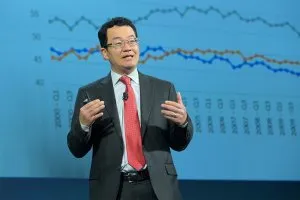As municipal governments struggle to balance their budgets, Joe Minicozzi suggests borrowing a page from the book “Moneyball: The Art of Winning an Unfair Game.”
“Moneyball” describes how Oakland A’s general manager Billy Beane bucked conventional wisdom to build a winning baseball team despite having less money to sign players. Rather than using traditional statistics to measure a player’s worth, Beane dug deeper into the numbers to find the stats that matter most and acquire players whose skills were undervalued.
“He challenged the way we think about baseball,” Minicozzi says.
Minicozzi, principal at the land-use consulting firm Urban3 in Asheville, N.C., is all about digging deeper into the numbers, too. But instead of trying to win a World Series, he’s helping communities improve their bottom line by “doing the math” when making decisions about where to focus development.
“That’s my bumper sticker slogan — do the math,” Minicozzi says.
Doing the math means taking a fresh look at how development patterns drive a community’s tax revenues. Rather than looking at the total tax production of a given piece of land to gauge its economic performance, Minicozzi advocates looking at tax production per acre as the best way to measure a piece of land’s relative value to the community.
It’s the same principle people use to compare the fuel efficiency of cars. People don’t look at the total miles per tank a car can travel to determine whether one car performs better than another. They look at the number of miles per gallon.
In case after case, Urban3 has shown communities that they get more mileage — i.e. tax production per acre — from development in their more dense urban centers than development in their less dense suburban fringes because the land there is more highly utilized and highly valued. “If you look at the data, the data will tell the story for you,” Minicozzi says.
Asheville, N.C., is a good example. After Urban3’s parent firm, Public Interest Projects, converted the vacant Asheville Hotel into a mixed-use retail/residential property, it ignited a wave of redevelopment throughout the downtown that increased the taxable value of property in the central business district from $104 million in 1991 to $665 million in 2010. The hotel, which sits on 0.2 acres, generates $634,000 in property taxes per acre and $83,000 in retail taxes. Meanwhile, the local Walmart, which sits on 34 acres on the outside of town, generates $6,500 per acre in property taxes and $47,500 in retail taxes.
Urban3’s work is part of a growing conversation about the economics of development decisions. With municipal budgets tight but expectations for public services high, many local governments are under financial siege.
As Urban3’s tax production per acre model suggests, smart growth with its emphasis on urban infill and compact development offers municipalities a way to glean a greater return from their most important asset — the land.
A 2013 report by Smart Growth America drives that point home. “Building Better Budgets: A National Examination of the Fiscal Benefits of Smart Growth” examined data from 17 previously completed studies from around the country and found that denser smart growth development patterns generate an average of 10 times more tax revenue per acre compared to less dense conventional suburban development. The report also found that smart growth saves municipalities an average of 38 percent on the upfront cost of infrastructure and 10 percent on the annual cost of public services.
“I was disappointed at how few studies had been done comparing different development types, but the outcomes were so consistent that we are very confident about what we found,” says Ilana Preuss, chief of staff at Smart Growth America, an advocacy group based in Washington, D.C.
“Building Better Budgets” is the first report to combine comparative data from multiple studies and calculate national averages. “The response we’ve received is quite remarkable,” Preuss says. “Local government leaders and elected officials across party lines are looking for this kind of information.”
Information about the fiscal differences between various development patterns is critical because decisions about where and how to focus growth ripple through municipal budgets in any number of ways, from the cost of constructing roads and providing police and fire service to property values and tax collections.
The studies that form the basis for “Building Better Budgets” show what happens when municipalities do the math. In Champaign, Ill., a study found that a smart growth approach to future city development could save $54 million in upfront infrastructure costs and $19 million in public services costs over 20 years. And in Raleigh, N.C., a study concluded that a six-story building downtown produces 50 times as much property tax per acre as the average Walmart store.
The goal of the report isn’t to tell communities what they should and shouldn’t do, Preuss says. The goal is to help communities make decisions with their eyes wide open about the economic consequences of what gets built and where.
“Every community has the right to decide what kind of development they want,” she says. “It comes down to giving local leaders clear and quantifiable information about the fiscal impact.”
A case study prepared specifically for “Building Better Budgets” compares the costs and benefits of three residential developments in the combined city/county municipality of Nashville-Davidson County, Tenn. Two are smart growth developments — an infill development in a brownfield location and a new urban development in a greenfield location — and one is a conventional suburban development.
Both smart growth developments proved to be better deals than the conventional suburban development. The new urban development cost 19 percent less in city/county services per housing unit and the infill development cost 13 percent less per housing unit. The infill development generated 1,150 times more net revenue per acre and the new urban development generated 148 times more net revenue per acre.
Such findings seem obvious. You’d expect it to cost less to provide services and infrastructure in a compact geography versus a sprawling one. And of course a more densely developed acre of land is likely to produce more tax revenue than a less densely developed acre.
“Even though it’s obvious, it has not been conventional wisdom,” Preuss says. “People have assumed that if there is a demand for (sprawl development), then whatever tax you can get out of that is good. Any development was good development because people wanted the tax base.”
But that approach counted on federal funding to help build infrastructure and on taxes/fees from new rounds of development to maintain infrastructure and provide services added during previous rounds. Like a Ponzi scheme, it could only last so long. When the Great Recession hit, poof went federal funding, poof went new development and poof went tax revenues as property values in the suburban fringe plunged.
“We are in a day and age where there are limited resources and [municipalities] have to spend their money wisely,” Preuss says. “A lot of places that built low-density development for a very long time are finding they can’t afford to maintain the infrastructure ... because they can’t generate enough revenue to cover the cost.”
Sprawl’s toll on a community’s long-term fiscal health was diagnosed at least as far back as 1974 when the federal government released a report called the “Costs of Sprawl.” Yet conventional suburban development remained the dominant form of development decade after decade.
“People like the suburbs, but we’ve known how (problematic) they are since the mid-1970s,” Minicozzi says. He likens the nation’s unhealthy appetite for sprawl to someone eating bacon every day. “We’re now paying the price for all those years of eating bacon,” he says.
Not everyone wants to change the menu. High density has always been tough for many people to swallow. But the numbers don’t lie about the benefits of density, Minicozzi says — especially in downtowns where the only way to grow is up. “As you’re stacking up stories, you’re stacking up dollar bills,” he says.
Urban3 uses geographic information systems technology to make Minicozzi’s point in highly visual ways — including a dramatic three-dimensional model that visualizes a community’s tax production per acre as spikes rising out of the ground. The taller the spike, the greater the tax production at that spot on the map. Whenever Urban3 applies this model to a city or a region, the tallest columns inevitably spring from the downtown core and other densely developed spots such as transit stops.
“People have never really looked at this study,” Minicozzi says. “Why hasn’t anybody done this before? Sometimes the simplest study is the most difficult to get at.”
Tax production per acre is one half of the equation for making economic comparisons between different development patterns. The other is the cost of providing public services.“
A lot of communities just look at revenue in a vacuum without looking at cost,” says Lee Sobel, director of public strategies for RCLCO, a nationwide real estate consulting firm based in Washington, D.C.
Using data collected from four cities, Sobel is creating a model to help municipalities calculate and compare the relative cost of services — police, fire, roads, utilities — for different development patterns. For example, how many fewer fire stations might be needed if growth is tightly focused rather than spread out?
“It’s intuitive on some level. There are always efficiencies that come with higher density. But it’s rarely [tabulated] in a comparative way,” Sobel says.
Together with tax production per acre, cost of services data can help municipalities weigh the long-term economics of where and how they choose to grow. “Since the Great Recession, a lot more communities are sensitive to the impacts of growth on their budgets,” Sobel says. “I think interest (in the cost of service model) will be high.”
Some municipalities may use the information to adopt policies that increase density such as encouraging infill development to make more efficient use of existing infra-structure, but they may also use it to determine whether they can afford continued low-density development as well, says Sobel.
“It’s not an all or nothing proposition. You can have both kinds of development,” he says. “You’re just pointing out that one does a more efficient job of paying for itself than the other.”
Brad Broberg is a Seattle-based freelance writer specializing in business and development issues. His work appears regularly in the Puget Sound Business Journal.








